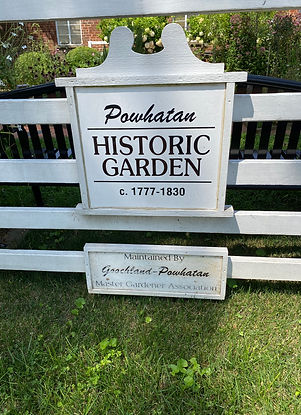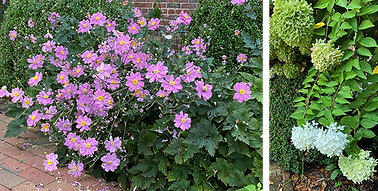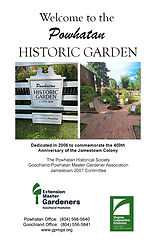Historic Garden Project
Located behind the Powhatan Historical Society Building - Powhatan, Virginia
The Powhatan Historic Garden
A Legacy Project

As a joint effort between the Goochland Powhatan Master Gardeners and the Powhatan Historical Society, dedicated in June 2006, the Historic Garden was created as a legacy project for the 400th anniversary of the founding of Jamestown. The plants selected and used for the garden were commonly found between 1777, the founding date of Powhatan County, and 1830, when the Old Jail was built on Courthouse Square.
In England, wealthy families during this time period had very formal, decorative gardens. The Historic Garden retains this formal style, with raised beds to separate the various types of gardening , and for ease of use. The planting beds; however, are divided into functional areas, as was the custom in Colonial times, and filled with plants grown in gardens in Powhatan during the time period 1777 to 1830.
The garden planting beds have something for everyone. There are vegetables, culinary and medicinal herbs, heirloom roses and irises, a shade garden, native plants bed and of course a bed we call “grandmother’s garden”, usually flowers planted by the lady of the house.The garden is located behind the Old Jail building – now the home of the Powhatan Historical Society and can be accessed from Main Street by a short walk to the rear of Courthouse Square or from Route 300 (Scottville Road) off Route 60. A map and brief history of the garden is located in the pocket hanging on the fence post by the bench.

The Powhatan Historic Garden is just one of six gardens we have diligently dedicated ourselves to over the past years. The garden is a beautiful photo spot for weddings or other groups and serves as a tranquil spot for those engaged in court business and law enforcement (as the sheriff’s office is next door). It’s a wonderful morning walk destination for visitors to the Powhatan Village as well as Powhatan residents.
Legacy Facts about the Garden
The Garden Style:
The plants selected and used for the garden were commonly found between 1777 (the founding date of Powhatan County) and 1830, when the Old Jail was built on Courthouse Square.
The Historic Garden retains the formal style that wealthy England families used – a decorative garden made with raised beds to separate the various types of gardening. As was the custom in Colonial times, we’ve divided the planting beds into functional areas - vegetables, culinary and medicinal herbs, heirloom roses and irises, a shade garden, native plants bed, and of course, a bed we call “grandmother’s garden” which contains a variety of heirloom-type plants, such as 4 o'clock (Mirabilish jalapa) and love-in-a-mist (Nigella Damascena).
-
Antique bricks along bed 13 and the East perimeter of the garden are from the now-defunct Miller-Polk Tavern, circa 1830.
-
Some garden bricks made in Clayville by Powhatan Clay Mfg. circa 1907 can be found throughout the paver pathways.
-
Fence sections are reproductions of fencing surrounding the Courthouse around 1840. The large spacing in the top section was for feeding of animals while citizens were in the Courthouse area.
-
Slate squares in the pathways are “Buckingham Slate”. Some is still in use on the roof of the Clerk’s Office (built in 1796) which is the oldest building on the Courthouse Square.
Scale Drawing of the Historic Garden

The Garden Beds

BED 1 - Norton Grape
Contains the Norton Grape (Vitis aestivalis x Vitis vinifera) - the oldest American wine grape. Cultivated during the 1830s in Richmond, Virginia by Dr. Daniel N. Norton as a hybrid of V. vinifera and V aestivales (American). Awarded a gold medal as best red wine at the 1873 Vienna World Exposition wine competition.


BED 2 - Shade Garden

BED 3 - Rose Garden

Replacing all wood edging
with brick pavers:


Perennials in the Garden - April:

Perennials in the Garden - May:

Perennials in the Garden - June:

BED 4 - Kitchen Garden

BED 5 - Vegetable Garden
In the 18th century vegetable garden, Southern gardens were formal squares and borders, unlike Northern gardens where straight rows were planted with shrubby borders of currants or small fruits. Gardens were numbered to allow notes taken to be used in subsequent years. Seeds were hard to come by and only available by saving seeds from the best specimens or from purchase off ships coming from Europe. We know from lists kept by Thomas Jefferson and George Washington that they experimented with varieties common in their day, but are not always the same as we plant. The vegetable plants in this garden vary yearly due to space limitations.
Source: Leighton, Ann. American Gardens in the Eighteenth Century: “For Use or for Delight” (Amherst: The University of Massachusetts Press, 1986)
BED 6 - Grandmother's Garden
Perennials in the Garden - July:

Perennials in the Garden - August:

Perennials in the Garden - September:

Cash Crops in the Garden

BED 7 - Medicinal Herbs
BED 8 - Native Plants



BED 9 - Cash Crops
Cotton (Gossypium hirsutum) - was first planted in Virginia in 1607. In the early 1900s, the boll weevil insect arrived in the US and devastated cotton production. Virginia’s cotton crop is now closely monitored and protected against the boll weevil. As part of this program, growing noncommercial cotton requires a permit from the Virginia Department of Agriculture and Consumer Science. Our plants are started indoors, where they germinate in 2 weeks when kept at a temperature of 75-80 degrees. The brown cotton boll is the seed pod, which opens to reveal the familiar soft cotton.
BED 10 - Culinary Herbs

BED 11 - Medicinal Herbs

BED 12 - Pollinator Garden

BED 13 - Wall Garden

Whiskey Barrels beside our Garden Bench
Tobacco (Nicotiana tabacum) - was brought to Virginia from Trinidad and cultivated by John Rolfe in 1612. Production of this crop formed the basis of Virginia’s economy. By 1770, large quantities of tobacco were being grown on land that would become Powhatan County. Tobacco beds are covered for the first 30-60 days to provide protection for the young plants, and its flowers are removed to encourage leaf production.

